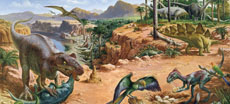 |
 |
 |
 |
 |
Produced
by the Population Genetics and Evolution class, Furman University |
||||
 |
 |
 |
 |
 |
Produced
by the Population Genetics and Evolution class, Furman University |
||||
 |
The
Jurassic: Brachiosaurus |
 |
||
| Brachiosaurus
was among the largest dinosaurs that ever walked the earth. As a sauropod,
Brachiosaurus had the typical long neck and tail, as well as
a relatively small brain (Wikipedia 2010). These dinosaurs were around
82 feet long from nose to tail (Wikipedia 2010). Estimates from fossils
also indicate that it might have weighed around 50 tons (Viegas 2010).
Because of their herbivore diet and enormous size, they likely had to
consume 440 pounds of food per day (Viegas 2010). They were fully terrestrial
giants who would have probably spent the majority of time grazing on trees
with little fear of predators due to its size (Wiipedia 2010). The actual size and classification of Brachiosaurus has caused some recent controversy. Due to a relatively incomplete fossil record, it is believed that the largest fossils found were specimens still in a subadult stage (Wikipedia 2010). One of the two species of Brachiosaurus, B. brancai, is often placed in a separate genus, Giraffititan (Taylor 2009). It is possible that Brachiosaurus could also have a developmentally mature morphology that is different than previously believed, and some argue that its classification should reflect these changes (Taylor 2009). Page by Lin-Lin Zhao |
 |
| Brachiosaurus altithorax caste in bronze, outside the Field Museum, Chicago. Photo from: Wikipedia. | |
|
Taylor MP. 2009. A re-evaluation of Brachiosaurus altithorax Riggs 1903 (Dinosauria, Sauropoda) and its generic separation from Giraffatitan brancai (Janensch (1914). J Vert Paleontol 29:787-806. Viegas J. 2010. Brachiosaurus: one of the largest dinosaurs. dsc.discovery.com. Accessed March 29, 2010. Wikipedia. 2010. Brachiosaurus. Accessed March 29, 2010. . |